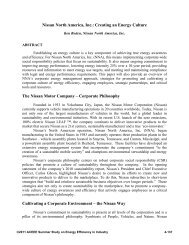Energy and Water Performance Benchmarking in the Retail Sector ...
Energy and Water Performance Benchmarking in the Retail Sector ...
Energy and Water Performance Benchmarking in the Retail Sector ...
You also want an ePaper? Increase the reach of your titles
YUMPU automatically turns print PDFs into web optimized ePapers that Google loves.
• Geographic distribution (for climatic impacts);<br />
• Servic<strong>in</strong>g of tenancies.<br />
A total of 103 survey responses were received. Of <strong>the</strong>se, 65 were used for greenhouse<br />
gas benchmark<strong>in</strong>g, <strong>and</strong> 74 for water benchmark<strong>in</strong>g. The responses from some sites were too<br />
<strong>in</strong>complete, or implausible to be useful, so were excluded. Note that some sites were only able<br />
to provide energy data or water data, so may not appear <strong>in</strong> both energy <strong>and</strong> water samples.<br />
Responses were received from shopp<strong>in</strong>g centres vary<strong>in</strong>g <strong>in</strong> size from 4000m 2 (Gross<br />
Lettable Area <strong>Retail</strong> (GLAR), i.e. <strong>the</strong> tenanted space) to a maximum of 160,000m 2 , although<br />
only centres with a GLAR of greater than 15,000m 2 were used <strong>in</strong> <strong>the</strong> analyses.<br />
Shopp<strong>in</strong>g centres of less than 15,000m 2 of GLAR were shown to have substantially<br />
different energy consumption characteristics than for centres with GLAR of greater than<br />
15,000m 2 . This is largely because <strong>the</strong> type of tenant mix, <strong>and</strong> <strong>the</strong> quantity of services provided<br />
at very small centres differ from that of larger centres. The distribution of residuals (<strong>the</strong><br />
difference between actual <strong>and</strong> predicted energy consumption) from <strong>the</strong> analysis of <strong>the</strong> whole data<br />
set is shown Table 2. The plot demonstrates <strong>the</strong> distributional differences between sub 15,000m 2<br />
build<strong>in</strong>gs <strong>and</strong> <strong>the</strong> rema<strong>in</strong>der of <strong>the</strong> shopp<strong>in</strong>g centres tested. Smaller centres perform<br />
disproportionately well, due to lack of common areas, <strong>and</strong> o<strong>the</strong>r services provided to shoppers.<br />
With <strong>the</strong> exception of three sites which provided car park sub-meter<strong>in</strong>g data, <strong>the</strong>se centres were<br />
excluded from <strong>the</strong> benchmark development.<br />
<strong>Energy</strong> <strong>Benchmark<strong>in</strong>g</strong><br />
Figure 1. Distribution of Residuals <strong>and</strong> Centre Size (GLAR)<br />
Shopp<strong>in</strong>g centres are diverse <strong>in</strong> <strong>the</strong> types of services offered to <strong>the</strong>ir tenants. This can<br />
pose a challenge to <strong>the</strong> creation of fair <strong>and</strong> relevant benchmarks, as few shopp<strong>in</strong>g centres are<br />
directly comparable or have <strong>the</strong> same mix of services. Two methodologies were considered for<br />
this study:<br />
• Multiple regression of all parameters<br />
• A model built up from a number of sub-benchmarks<br />
©2010 ACEEE Summer Study on <strong>Energy</strong> Efficiency <strong>in</strong> Build<strong>in</strong>gs<br />
3-4




